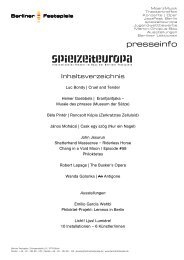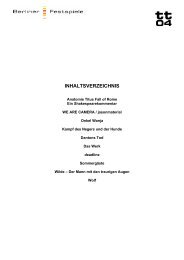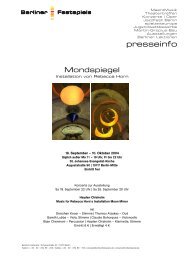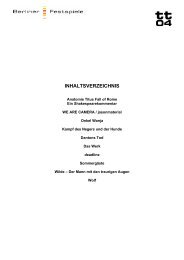konzerte04-pressemappe.pdf - Berliner Festspiele
konzerte04-pressemappe.pdf - Berliner Festspiele
konzerte04-pressemappe.pdf - Berliner Festspiele
Erfolgreiche ePaper selbst erstellen
Machen Sie aus Ihren PDF Publikationen ein blätterbares Flipbook mit unserer einzigartigen Google optimierten e-Paper Software.
oard moved by four rollers, so that the strings of the higher or lower notes were struck by the same<br />
hammers. This patent must have been in France.<br />
In France, Sebastian Erard patented an improved version of his double-escapement action, while his<br />
nephew Pierre took out a patent for the same action in London (number 4631, dated 22 December<br />
1821). This was also the fi rst patent that Pierre took out.<br />
In 1840, under patent number 8643, plate number nine, he describes his patent for the front bat pin<br />
with a key bushing. This is a simple component, now standard on all pianos today, that is great for<br />
minimizing wear on the key bushing. It was little things like this that the Erards were so good at. Not<br />
only did they want to improve the sound and fl exibility of the action and piano, they tried to make the<br />
tuner‘s life easier.<br />
Pierre made some other modifi cations to the piano, to make life easier for those who worked on<br />
them. However, not all were taken up for very long. Patent number 13,816, from 1851, shows some of<br />
Pierre‘s work, this one being for a tuning device.<br />
„Figures 3 and 4 show a plan and section of a new screw apparatus for tuning the wires of a grand<br />
piano. In Figure 4 the tuning end of the string (a) is represented as passing through a groove or hole,<br />
and coming out at (b), then turning round the stem of a screw (c), and also round the stem of the<br />
screw (d). These two screws (c) and (d), by the pressure of their beads, keep the wire down tight<br />
upon the surface of the metal slides (g) in the guides or sockets (h), and passing under a bridge or<br />
rest (i). Behind each of the slides (g) is a screw (j) abutting with a shoulder (k) against a metal standard<br />
(i), forming part of the socket (h). The screws (j) may be turned with a key fi tting on their square<br />
heads, shown in the end view, Figure 5. These said screws (j), by screwing up into the sliders (g),<br />
draw them under the bridge (i) towards the standard (i), and tune up the string to the proper pitch.<br />
By a contrary motion of the screws the wires can be slackened at pleasure.“<br />
On the same paper he went on to describe his new fl ange for grands. It is like the Billings fl ange we<br />
all love to work on, but instead of brass it is made of wood.<br />
„Figures 6 and 7 show a plan and a side view of a newly invented hammer butt for Erard‘s Patent<br />
Action, with the improvement of a regulating screw (m) to every separate hammer centre. This<br />
arrangement is of great importance, inasmuch as it admits of every separate hammer centre being<br />
regulated with the requisite degree of tightness, one screw only being required for each butt. Another<br />
advantage in these improved hammer centres is that they may be left very free when fi nishing the<br />
instrument. This greatly facilitates producing a light touch. The screws (m) are also useful to tighten<br />
the hammers should they become too free from the effects of a warm atmosphere, or to loosen<br />
them should they become too tight from the effects of a moist atmosphere. At (n) is shown a slit in<br />
the butt in which the pin (o) is inserted at the end, and this is of suffi cient size to give the slit (n) a<br />
tendency to open.“<br />
And fi nally, the bulk of this patent was taken up by his improvement to the bridge. On this submission<br />
he is not modest about their pianos:<br />
NOW KNOW YE, that in compliance with the said proviso, I, the said Pierre Erard, do hereby declare<br />
that the nature of my said Invention, and the manner in which the same is to be performed, are fully<br />
described and ascertained in and by the following statement thereof, reference being had to the<br />
Drawing hereunto attached, and to the fi gures and letters marked thereon, that is to say: -<br />
The comparison made in regard to pianofortes of all nations at the Great Exhibition has established<br />
more fully than ever the reputation and superiority of my pianofortes over those of the old principle.<br />
My original repetition action, my new proportions in stringing the instruments, and the more solid<br />
construction of the frame have rendered the modern pianofortes so perfect as to leave nothing to be<br />
wished for in mechanical action, tone, and durability. There is, however, one point which, in my mind,<br />
may leave room for improvement; that is, the pressure of the wires on the sounding board. It has








